Restoring a bathtub with liquid acrylic: do-it-yourself enamel coating repair
When faced with the need to replace a bathtub that has lost all its attractiveness, the owner feels horror.After all, replacement will entail a full-scale repair, which means a lot of time and money. A reasonable alternative in this case is to restore the bathtub with liquid acrylic, which you can also do with your own hands.
We will tell you how to restore a damaged coating. The article we presented provides step-by-step guidance for carrying out the entire cycle of work: from preparing the plumbing to applying the composition. Taking into account our recommendations, your bathtub renovation will be completed perfectly.
The content of the article:
Options for bathtub repair with liquid acrylic
The familiar bathtub, in which the mother bathed her as a baby, began to look unpleasant over time - chips appeared, rust appeared, and in places it became rough. And it became simply impossible to wash it clean.
Many owners of cast iron and steel bathtubs have to face this situation. Their plumbing fixtures are typically 10, 15 or more years old. After 12-20 years of use, your favorite bathtub looks very deplorable, and to clean it, you will need to make a Herculean effort every time.
To repair old enamel without starting a horrific renovation, you can use liquid acrylic. This material was specially developed to resurface and improve the performance of bathtubs and other sanitary products.

To restore peeling enamel of an old bathtub, you can use several methods:
- invite an expensive specialist;
- find a cheap craftsman;
- do everything yourself.
Cooperation with an expensive and experienced craftsman can be very pleasant - the end result of his work will delight the whole family and many acquaintances for many years. But the work of such a specialist cannot be cheap.
And reviews about the company itself should be positive. It’s good if this company has already done similar repairs for one of your friends/acquaintances, and they were satisfied.
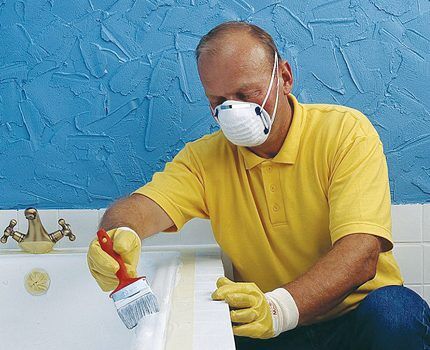
The too high cost of services, which stands out against the general background of similar offers, should alert you. Such companies, according to employees, use only imported materials.It is the high cost of foreign acrylic and the high level of professionalism of their craftsmen that explains their prices.
In reality, these companies most often turn out to be scammers. The work is carried out in violation of the technology, and the material itself is further diluted to a too liquid state in order to reduce its consumption. This is fraught with peeling, yellowing and peeling of the new enamel.
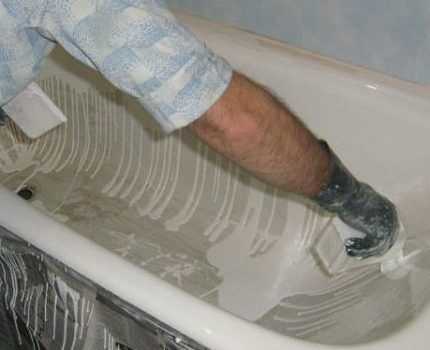
During the work process, craftsmen from dishonest companies take additional money for each of their actions. After payment, no one answers calls from the indignant owners of the bathtub. They don't correct their mistakes.
As an alternative to an expensive master, find a cheap one. There are a lot of offers to do it quickly, efficiently and, most attractively, inexpensively, on the Internet. But it will be more expensive to contact such miracle professionals.
Firstly, no one will work at a loss. And high-quality material cannot be cheap. Secondly, you need to add to the cost of acrylic the painstaking work of preparing the surface. All this in total cannot be cheap.
The use of poor materials and violation of technology will only please you at the price. In a couple of months, the bathtub, at best, will turn yellow in places, and at worst, it will completely begin to peel off.

The best option is to do the work of restoring the enamel surface of the bathtub yourself.After all, who, if not yourself, can you completely trust without fear of deception?
Carrying out the restoration process on your own will require additional knowledge, consumables, and patience. You will also need to understand the essence of the chosen type of repair work and take into account important details, without which it is impossible to achieve the optimal result.
Stages of the recovery process
Having decided to do everything yourself, you have to stock up on free time, patience and the desire to do everything efficiently. Moreover, many home craftsmen like to do homework themselves.
After all, what could be more pleasant than having conquered another difficulty, then admire a job well done for several years and be proud of it.
Visual assessment of the scope of work
The first thing that needs to be done to restore the enamel coating of a bathtub that has lost its decent appearance is to estimate the total size of the upcoming work.
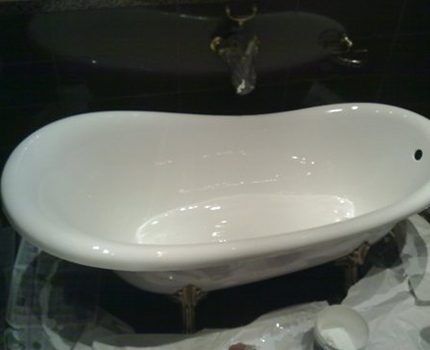
To do this, you need to carefully examine your container, paying attention to the following points:
- suitability of the bath for further use;
- method of its installation;
- joints with the wall;
- the presence of a tiled screen;
- drain-overflow condition;
- bath size;
- the current color of the product and the desired color after restoration;
- the condition of the enamel on the sides and bottom of the container;
- presence of chips, cracks, rust;
- the state of the tap - whether it is flowing or not.
All these nuances are important for organizing the further repair process. Firstly, the presence of chips, deep cracks and rust can significantly affect the overall condition of the container and its suitability for long-term service.
If the damage is minor, then the rust can be easily cleaned, chips and large cracks can be repaired with automotive putty, and small ones can be repaired with liquid acrylic. This repair material, like a diving suit, tightly fits all the depressions and bulges, successfully masking the cracks.

If there are tiles in the bathroom, they must be protected from accidental contact with materials and tools during the renovation process. To do this, you will need masking tape, a special film to protect against construction dust or newspapers, unnecessary wallpaper, and rags. It is better to use paper or cloth for the floor, and film and tape for the walls and screen.
Worn parts of the drain and overflow will have to be replaced with new ones, because they still need to be removed during restoration work. If these products are in good condition or have recently been replaced, then you will be able to save on buying new ones.
It is absolutely forbidden to begin restoration work with a leaking faucet. Water dripping onto a surface treated with poured acrylic or, even worse, getting under the layer of material during the pouring process will ruin everything. The coating will not stick or will begin to fall off.
The required volume of liquid acrylic depends on the size of the bathtub. The most common containers are 1.5 or 1.7 m long. There are also non-standard options that significantly exceed this length. In such cases, it is important to remember to mention this fact when purchasing acrylic material. After all, you need to buy a quantity that is completely enough to restore the enamel.
As for color, liquid acrylic has a snow-white, creamy or milky white color. If a different shade is required, you must immediately purchase a tinting paste from the same manufacturer. Will introduce you to the technology of painting plumbing fixtures next articlededicated to completing this work.
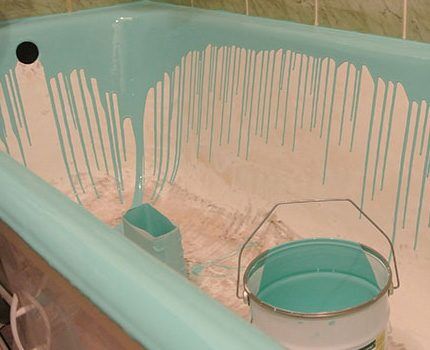
Having carefully examined the inner surface of the bathtub, you will need to prepare a power tool with an appropriate attachment or, in its absence, a wooden block with sandpaper. All this will be useful for getting rid of excess smoothness remaining on the side or inner sides of the bathtub.
Cleaning, washing and drying
When all preliminary measurements have been made and the necessary tools have been prepared, you can begin to prepare the container for restoration. To do this, you need to go over its entire surface with a grinder with an emery grinding wheel or other abrasive discs.
You can also use a drill with a rubber attachment and sandpaper to give all areas a uniform roughness. If you don't have a power tool, then a simple wooden block and sandpaper will do. Only the processing time will take much more.
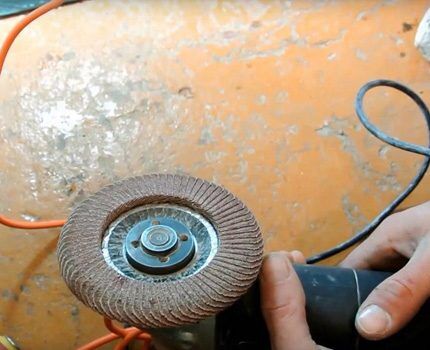
Sanding is a dusty and messy activity. It is important to use personal protective equipment to protect yourself from dust and pieces of old enamel getting into your nose, ears, eyes and lungs.
Having finished sanding, remove dust not only in the container itself, but also in the entire room.Then the bath is thoroughly washed with soda, pemolux or another substance. This is necessary for degreasing. It is better to do this procedure 2-3 times, rinsing everything thoroughly with warm water.
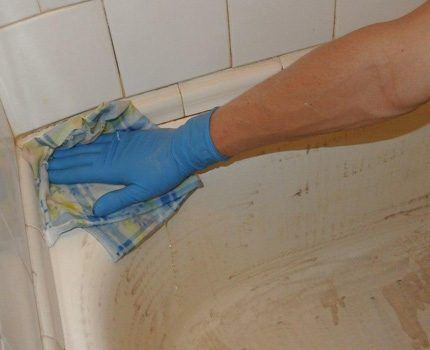
After finishing washing, you have to dry everything. Warm water washes away the degreaser and ensures quick drying. But in hard-to-reach places - at the junction of the bathtub with the wall, in the corners, water always remains.
To remove it, it is better to use a household or hair dryer. You also need to remove the drain and overflow grates and clean the areas under them.
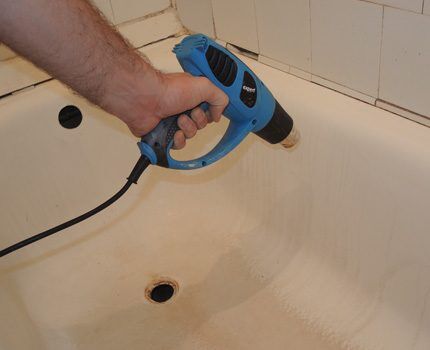
After drying, it is better to vacuum everything thoroughly again and stick a protective coating on the walls and screen. The rest of the furniture in the bathroom also needs to be wrapped. Lay paper/old newspapers on the floor, and wrap the faucet above the bathtub in film or a plastic bag.
Grinding, degreasing and drying will ensure the best possible adhesion of the surface to the bulk material.
Acrylic: how to choose and prepare
To get a high-quality coating in place of old and peeling enamel, you need to buy good bulk acrylic and prepare it correctly. So, for a bathtub 1.5 m long, about 3 kg of liquid acrylic is used. Consumption depends on the individual characteristics of the purchased product - it is different for all manufacturers.

There are many different offers on the building materials market.As evidenced by the practice of using self-leveling acrylic by various craftsmen, the best are Stakryl Ecolor, PlastAll, ECO-BATH.
When buying liquid acrylic, you should definitely ask for documents confirming its quality, safety and that it really relates to this material. After all, it is not at all difficult to purchase a fake without making sure that you have the appropriate documents. You also need to look at the expiration date - expired material is unsuitable for repair.
Qualitative liquid acrylic comes complete with a bottle of hardener. These 2 substances must be thoroughly mixed. This must be done strictly according to the instructions given by the manufacturer. Moreover, the mixing, hardening and drying time differs for different brands.
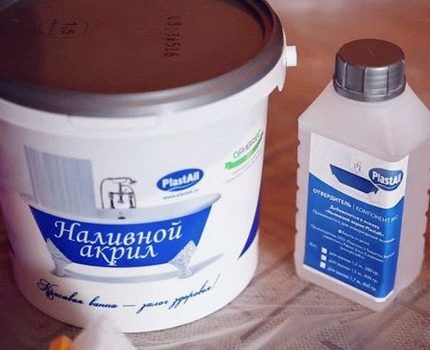
To properly prepare the mixture, you need to carefully and for a long time, as indicated in the instructions, mix the components. The acrylic should become uniform, both at the bottom of the container and along the side walls. If this is not achieved, the heterogeneous material that formed the new acrylic surface of the old bathtub will show yellow spots.
Having finished kneading according to the instructions, you may have to wait 5-10 minutes and then repeat the mixing process. These are also the individual characteristics of a particular material. It is important to take your time here so as not to whip it into foam. We must try to avoid the appearance of bubbles.

If the future coating is planned to be colored, then the required amount of tinting paste is added during the mixing process. If the updated bathtub is black, it is better to immediately buy liquid acrylic called shungite. Its formula is well developed by the manufacturer, which will protect the home craftsman from errors in calculating the required amount of dye.

Another important point in preparing liquid acrylic is that you cannot add solvent or any other substance to it other than the hardener included in the kit. Otherwise, this material will have nothing in common with liquid acrylic. You need to immediately buy the required volume so that it is enough to pour over the entire bath.
Acrylic pouring and cleaning
When the mixture is ready, you need to quickly and carefully pour the prepared surface of the bath. To do this, take a plastic glass, put on gloves and begin to water the container, starting from the far corner.
They go in a circle, generously pouring liquid acrylic on the side. Having closed the upper circle, begin pouring the second circle from the middle of the sides. At the bottom, use a rubber spatula to level everything.
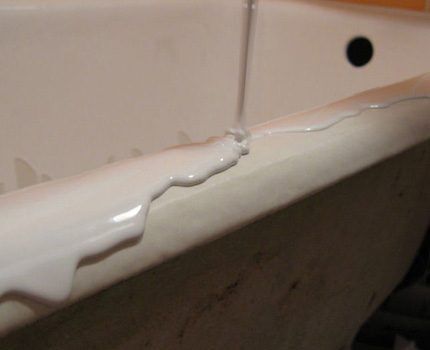
If air bubbles have formed on the surface, it is better to take a wide brush and, barely touching the fresh layer, burst them. This is done before the material begins to harden. To prevent liquid acrylic from flowing onto the floor through the open drain hole, place a small glass or other container there.
When pouring is completed, care should be taken to ensure that the renewed bath dries smoothly and completely. After all, the entry of dust particles, hair, lint and other things will spoil the impeccable appearance of the coating.
The complete drying time is clearly indicated in the instructions. This is from 24 to 48 hours, sometimes more. Only when everything is dry, you need to carefully trim the drops of acrylic at the bottom of the drain hole from the outside and put the drain and overflow in place. You can also remove protective coatings from walls, furniture, floors and use the bathroom for your own pleasure.
High-quality update and complete bath restoration will allow you to enjoy the beautiful container for many years. It is important to care for it properly and not drop a hammer or knives inside. Scratches that occur during use can be easily repaired with special products included in the repair kit for acrylic bathtubs.
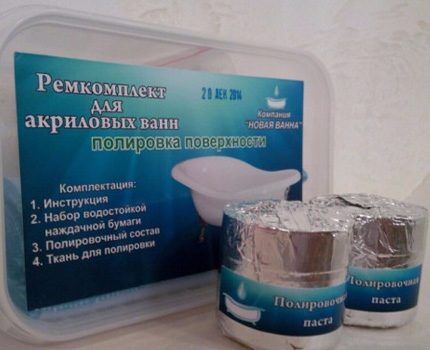
You should care for the self-leveling acrylic coating in the same way as you would for an acrylic bathtub - wash it with a soft soapy sponge or a special product.
Annoying mistakes: what to watch out for
Independent work on updating a bathtub with liquid acrylic requires not only adherence to a certain technology. It is also important to avoid making gross mistakes that will ruin all your efforts.Moreover, knowing about the features of the material itself and not having practical experience working with it, it is quite easy to miss something important.
In the future, such small nuances will quickly render the recently restored enamel unusable. It may begin to flake and peel off the surface of the bathtub.
The main mistakes made during restoration work:
- buying a fake instead of liquid acrylic;
- incorrect mixing of components;
- poor surface preparation;
- moisture residues in hard-to-reach places;
- unsuitable temperature conditions;
- ingress of dust and other inclusions;
- early operation of the restored capacity.
Liquid acrylic is in demand among craftsmen professionally involved in repair work. Also among ordinary people who decided to independently restore an old and damaged bathtub. Therefore, it is quite easy to buy a fake instead of quality material.

Unscrupulous sellers, in order to profit from inexperienced consumers, offer expensive acrylic made in Finland, Germany or Slovenia. In fact, these countries have not heard anything about the products supposedly produced in them.
Another mistake is incorrectly mixed ingredients. To avoid such an annoying misunderstanding, you need to carefully read the manufacturer’s instructions and only then begin to follow them to the letter.
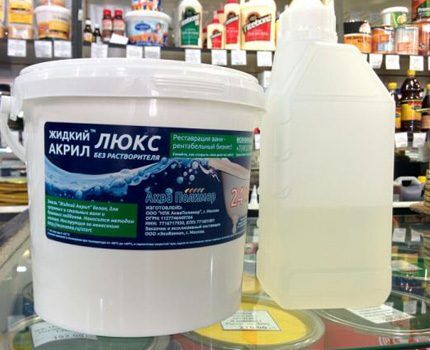
If you prepare the surface of a restored bathtub “at random”, ignoring the recommendations of experienced craftsmen, the result will be disastrous. Within a month, bubbles will appear and the gloss will peel off, revealing the dull outlines of the old container.
Water remaining in some places will ruin the entire work. The fact is that liquid acrylic will peel off from a wet surface.
All work must be carried out at a temperature not exceeding 25°C. Otherwise, the drying process of the material can significantly speed up, which is especially sad for the home craftsman. An experienced specialist, having assessed the temperature in the room, will act in accordance with it.
The ingress of dust, drops of water, lint from towels and other foreign objects onto the wet surface of the restored enamel will ruin its appearance. Trying to correct such a nuisance can make the situation even worse. It is better not to use the room at all until the surface is completely dry.
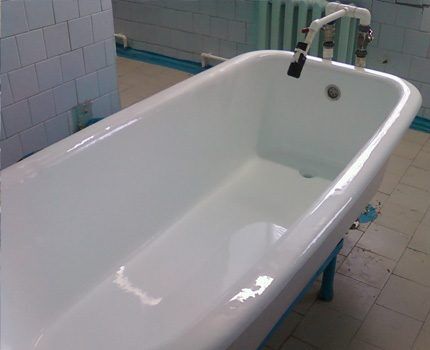
Compliance with the time frame specified by the manufacturer of liquid acrylic is of great importance. If it is written that after applying the material it must take 48 hours for it to completely dry, then you cannot take a bath before this period has expired. Otherwise, unsightly dents will appear, because the acrylic has not had time to completely harden.
Knowing about all these mistakes, you can try to avoid them.Then the work will be done with high quality, and the updated plumbing will delight you with its ideal smoothness and long service life.
The details of repairing cast iron bathtubs are given in next article. It describes in detail the technology for restoring plumbing fixtures and provides useful recommendations.
Conclusions and useful video on the topic
Detailed video for DIY restoration of enamel coating using liquid acrylic:
Video with explanations on how to properly prepare the surface before acrylic treatment of a bathtub and apply liquid acrylic with your own hands:
A visual video of how cheap specialists work, who incorrectly prepared the surface of the bathtub and used counterfeit or expired material, which they passed off as liquid acrylic:
By restoring the enamel of your favorite bathtub yourself, you can save a decent amount from the family budget. The work done will allow you not only to enjoy the brilliant appearance of the product, but also to feel a real surge of pride from the fact that it was all done with your own hands. And your nerves will be fine, having avoided communicating with bad craftsmen and hacks.
Would you like to tell us about how you restored your own bathtub with acrylic? Do you want to share technological subtleties known only to you? Please write comments in the block below, post photos on the topic, ask questions about points of interest.




Of course, we ourselves did not dare to restore the enamel of an old bathtub ourselves. They invited a master from a company that has been doing this work for many years.He did everything quickly and efficiently, the price suited us quite well, since we do not live richly, not to say poorly, every penny counts! Therefore, we recommend that you use this method of repairing a bathtub bowl.
It seems that it’s already there, I can do everything, a guy with hands, it’s written how to do it, in detail, but just like that, not everyone gets around to taking on such a job. I'm afraid I'll screw it up and make it even worse than it is now. The bathtub, of course, is in a sad state, and getting a new one is not an option now. It’s really cheaper to buy glass and pour it in, but what to do with the family while it all dries. And it probably stinks quite a bit. In general, I want it and inject it.
If it’s with your hands, then there shouldn’t be any problems with restoration. You can send your children to grandma for the weekend, or just keep a close eye on them and don’t let them near you. Another thing is that such restoration is a temporary measure. It will be in good condition for 3-4 years, then problems will start again.